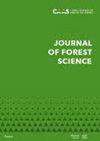Managed vs. unmanaged Fagus orientalis Lipsky forests: Structure and diversity of natural regeneration in northern Iran
IF 1.1
Q3 FORESTRY
引用次数: 1
Abstract
The predominant natural disturbance regime within an old-growth Oriental beech (Fagus orientalis Lipsky) forest has been imitated in order to continue the forest cover. It is unclear how much the silvicultural characteristics of regeneration in a managed forest differ from those in an unmanaged old-growth forest subject only to natural dynamics. In this study, we compared important quantitative (e.g. height, collar diameter, crown width, length of spring shoot on the main stem and length of the uppermost internodes) and qualitative (e.g. healthy, mode of branching and stem form) silvicultural characteristics of beech saplings within the gaps between an unmanaged old-growth Oriental beech compartment and a managed forest in the northern Iran ten years after a single harvest entry using a single-tree selection. Canopy gaps larger than 100 m2 with visible remnants of gapmakers (i.e. stumps) were included in this study. The saplings’ characteristics of both compartments were within typical ranges for an old-growth beech forest. Small, but important differences were also observed. The value of beech saplings’ density in the managed compartment (4.9 ± 0.7 SE) was significantly (P < 0.05) higher than the unmanaged one (3.4 ± 0.6 SE). Conversely, the value of the Menhinick Richness index in the unmanaged one (0.96 ± 0.05 SE) was significantly (P < 0.01) higher than the managed compartment (0.80 ± 0.04 SE). The sapling spring shoot length in the unmanaged compartment (13.3 ± 1.7 SE) was also significantly (P < 0.01) higher than the managed one (7.3 ± 0.7 SE). Relying on beech trees in a managed compartment will hamper the stability of future forest stands. The imitation of the old growth forest must be complete. To increase the resistance of the forest stands to adverse conditions, pay attention to the tree species richness at the time of marking.有管理与无管理的东方毛茛林:伊朗北部自然更新的结构和多样性
为了延续森林覆盖,模拟了原始东方山毛榉(Fagus orientalis Lipsky)森林中主要的自然干扰机制。目前尚不清楚,在受管理的森林中,再生的造林特征与仅受自然动态影响的未受管理的原始森林有多大不同。在这项研究中,我们比较了伊朗北部一个未管理的原始东方山毛榉区和一个管理的森林之间的空隙中山毛榉树苗的重要数量特征(如高度、树冠直径、冠宽、主茎上春芽长度和最上层节间长度)和质量特征(如健康、分枝模式和茎形)。本研究包括大于100 m2的林隙和可见的造隙残余(即树桩)。两室树苗的特征都在原始山毛榉林的典型范围内。也观察到微小但重要的差异。管理室山毛榉树苗密度值(4.9±0.7 SE)显著高于未管理室(3.4±0.6 SE),差异有统计学意义(P < 0.05)。相反,未管理室的Menhinick丰富度指数(0.96±0.05 SE)显著高于管理室(0.80±0.04 SE) (P < 0.01)。苗木的春枝长度(13.3±1.7 SE)显著高于苗木(7.3±0.7 SE) (P < 0.01)。在一个有管理的隔间里依赖山毛榉树会妨碍未来森林的稳定性。对原始森林的模仿必须是完整的。为了增加林分对不利条件的抵抗力,在标记时要注意树种的丰富度。
本文章由计算机程序翻译,如有差异,请以英文原文为准。
求助全文
约1分钟内获得全文
求助全文
来源期刊

Journal of forest science
Forestry-
CiteScore
2.30
自引率
9.10%
发文量
48
审稿时长
6 weeks
期刊介绍:
Original results of basic and applied research from all fields of forestry related to European forest ecosystems and their functions including those in the landscape and wood production chain are published in original scientific papers, short communications and review articles. Papers are published in English
 求助内容:
求助内容: 应助结果提醒方式:
应助结果提醒方式:


